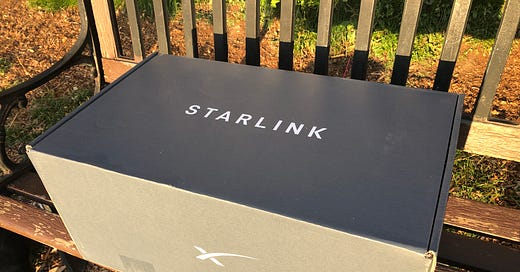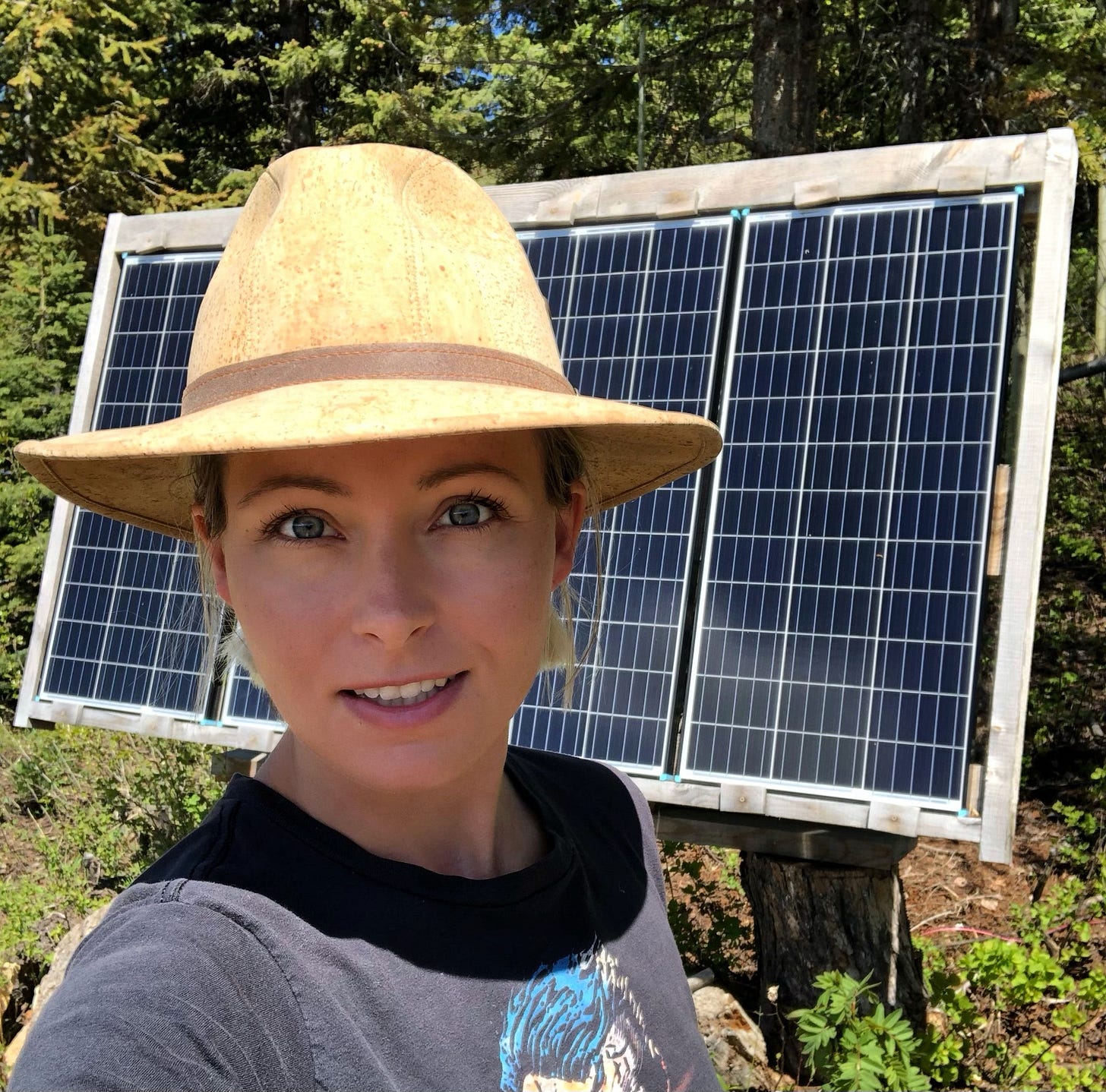Currently, I use an LTE wifi router. It uses the same signals as a cell phone, boosts it and converts it into wifi which my other devices use. It doesn’t work well, sometimes not working at all. A few people have recommended Starlink, so I decided to give it a try. It costs a bit more than my current wifi, $160 per month and I’d also have to buy the hardware - currently at a discount for rural addresses.
Me and My Dumb Principles
As mentioned in ‘Off-Grid and Offline’, Starlink wigs me out. Thousands of satellites orbiting the globe - currently over 5,000 with plans for more. It delivers high-speed internet to the whole planet. It’s cool - but to me, it’s a bit intrusive.
The skies here are exceptionally clear, and watching shooting stars is a favourite pastime. As we watch the night sky, we can see the Milky Way galaxy, and note how fast the moon moves through the sky. The occasional satellite moves along on a solo mission, and we wonder what it might be for. I enjoy sitting in calm silence, without a person around for miles.
Enter - Starlink. One satellite appears on the horizon, soon followed by another, then another. The Imperial March plays in my head.
The night sky is changed. Suddenly we’re not in the middle of nowhere, enjoying a connection with the natural world. Suddenly there’s a skyscraper worth of lights charging across the sky. Intrusive, it is.
Give it a Try
I can be very stubborn and hold strong to my principles, but I decided to give it a try. Everyone’s raving about it, it’s only a bit more money than my current wifi, and there was a deal for the hardware. I read that it requires a fair bit more power to run than my current wifi but, might be manageable? The only way to know for sure is to give it a try.
It arrived fast. Less than two weeks after I pulled the trigger there it was in my mailbox. Resisting change, it took me a couple of days to actually set up. It was simple. A little too simple. Put the dish-thing somewhere with a good view of the sky, plug it into the router, plug that into power, and hit some buttons on the app. No off/on switch, no lights telling me what’s happening. Plug in and go.
Falling in Love
It. Worked. Great. Holy Toledo, it was fast! To test it, I got every streaming platform on my computer playing at the same time and at high resolution: Disney, Prime Video, YouTube, and Crave, all at once. Then I did the same on my iPad, my phone, and Curt’s phone. Not a hiccup. For a moment I fell in love, that kind of new love where you’re excited yet cautious.
Then I looked at the power consumption. Where my old router barely registered a Watt, the Starlink was hitting 60 Watts. My heart sank. This was not sustainable on my minimal solar-powered system. Not by a long shot. We kept it going for a few days to see if its consumption would decrease. It did a little, but not enough. How could this device use that much more than an LTE router?
After three days our batteries were dangerously low, while still charging during the day. Part of what I use my internet for is security cameras. I like to keep things running if I leave, so this would not do. With this power consumption level, I would need a solar array and storage 5 times bigger than I have, just to run Starlink.
FIVE TIMES
Having never depleted our batteries so low, we turned it off for the night to give them a break. The next day when I fired the Starlink back up, it started normally. The dish moved around, it connected to devices but wasn’t working. It was consuming power, not working and not telling me why. I’ve spent more money and set aside my principles for a device that doesn’t tell me why it’s not working and consumes 5X more power?
It was going back.
I’m not a big conspiracy theorist or hypochondriac, but for the two nights that we had Starlink running we slept like garbage. We both woke up anxious and restless - probably a coincidence..
Musk has an alleged goal of making the internet accessible to everyone globally. What I experienced was not that. What I found was that it’s available at a cost. You need to be on-grid or have an expensive independent system. For the nearly 20% of the world’s population that doesn’t have electricity, Starlink is far from feasible.
Letting go of High-Speed Wifi
To quote a previous article, ‘Off Grid and Offline’;
Being off-grid isn’t about being connected for every moment of the day, far from it. A big part of living out in the woods is to disconnect. After the initial panic of losing connection, a familiar feeling came back - a peaceful feeling. Instead of worrying about everything that’s wrong in the world, I can feel comfortable that things are mostly right in mine.
On the bright side, the returns process was a breeze. A couple of clicks in the app, and a return slip was ready to be printed. As soon as the box was at the courier my money was refunded.
At What Cost?
I was willing to set aside my principles and try it, but ultimately Starlink comes at too high of a cost. I’m not willing to buy and maintain enough infrastructure to keep it running. The difference in cost per annum can be better used. I found the device to be overly simplistic to the point of unmanageable. Though the satellites in the sky will always feel like an intrusion, I can choose not to let high-speed internet invade my personal space.









I always enjoy you life up there, all about live , learn and adjust. The view and freedom you have , most will never encounter. Best wishes, be safe and God Bless you both .